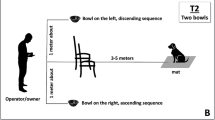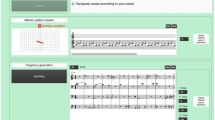Summary
The analysis of the songs of bullfinches that as juveniles had learned a human melody or song parts of a canary give insights into the perceptive faculties and into the learned coordination between the muscles of the vocal organ, the syrinx — responsible for the pitch of the note — and the respiratory apparatus, which determines the different durations of consecutive notes. Our study is focussed on determining whether the bullfinch can learn the temporal pattern of a song, and if it perceives melodies. Does a bird perceive the series of notes in the human melody as a series of unrelated elements or is its perception more humanoid, for example by determining the relative proportion of ascending and descending intervals?
The following results were obtained: (1) A bullfinch learned a human tune of 45 notes from a human tutor according to the tune’s relative pitch value (transposition) and in a high corresponding rhythm (e. g. semi-quaver, quaver or crochet). The bullfinch raised by a canary copied 13 different syllable types from its foster parent. The learning of the exact duration of each single note of the melody indicates that the bullfinch can alter each single respiratory pulse for singing according to the well-defined duration of the alien song model. (2) The human tutor and the bullfinch sang the identical melody, but with a different absolute pitch. The bullfinch, raising it by a semitone, transposed the melody. Unlike the tutor, who repeated the melody with a variable absolute pitchr the bullfinch always sang the melody with an almost constant absolute pitch. The transposition of the melody indicates that the bullfinch perceives in a series of notes with a duration of 35 s the general aspects of the sequence of notes, such as the relative pitch, the musical intervals between consecutive notes and the overall temporal pattern. (3) The comparison between the duration of notes and pauses of identical vocal pattern between the tutor’s song (human and canary) and the pupil’s song (bullfinch) reveals that bullfinches can copy the duration of each individual note according to its position within the song with high accuracy. To achieve this, the pulse programme for the expiratory muscles involved in the steering of the temporal pattern and vocal intensity must remain under very tight control to produce the well defined duration of each individual note (e. g. semi-quaver or eight).
Zusammenfassung
Die Analysen von menschlichen Melodien und von Gesangsstrophen von Kanarienvögeln, welche Gimpel während ihrer Jugendentwicklung gelernt hatten, ergeben nicht nur einen Einblick, wie genau Singvögel Rhythmen und Tonintervalle von Vorbildern übernehmen können, sondern erlauben auch Rückschlüsse, ob Singvögel Lautfolgen lediglich als eine voneinander unabhängige Reihenfolge von Lauten oder entsprechend der Melodiewahrnehmung beim Menschen als melodische Einheit wahrnehmen können. Folgende Ergebnisse werden eingehend dokumentiert: (1) Ein Gimpel erlernte die 45 Noten umfassenden, gekürzten Melodien „Im tiefen Böhmerwald” und „Abend wird es wieder”, sowohl im Rhythmus als auch in den Intervallschritten weitgehend vorbildgetreu. Der von einem Kanarienvogel aufgezogene Gimpel erlernte 13 von der Gimpelnorm sehr stark abweichende Lautgruppen in der vom Kanarienvogel gesungenen Folgebeziehung. (2) Der menschliche Lehrer und der Gimpel singen die Melodie in einer unterschiedlichen absoluten Tonhöhe. Der Gimpel transponiert die Melodie, d. h. er erhöht die absolute Frequenz der einzelnen Töne um einen Halbtonschritt. Während der menschliche Lehrer von Strophe zu Strophe in der absoluten Tonhöhe der einzelnen Noten variiert, in einer ungefähren Tonlage von As-Dur pfeift, singt der Gimpel die identischen Noten in den Wiederholungen sehr konstant in A-Dur. Das Transponieren liefert den Nachweis, dass der Gimpel Lautfolgen nicht nur entsprechend der menschlichen Wahrnehmung als Melodie verarbeiten, sondern auch entsprechend pfeifen kann, obwohl bei den Singvögeln die für die Analyse der Beziehungen zwischen aufeinanderfolgenden Lauten wichtigen Gehirnzentren des Menschen völlig fehlen. (3) Der Vergleich der Noten- und Pausenwerte der einander entsprechenden Laute zwischen dem Vorbild und der Nachahmung zeigt, dass Gimpel sowohl die exakte Tonhöhe und die Tonhöhenintervalle zwischen aufeinanderfolgenden Tönen, als auch die den Melodierhythmus bestimmende Lautdauer für jeden Laut genau auf die Vorgabe durch das Vorbild abstimmen können. Für diese Leistung wird der an der Lauterzeugung beteiligte Atemstrom genau an die jeweilige Dauer der unterschiedlich lange ausgehaltenen Note angepasst.
Similar content being viewed by others
Literatur
Calder, W. A. (1970): Respiration during song in the Canary (Serinus canaria). Comp. Biochem. Physiol. 32: 251–258.
Carterette, E. C. & Kendall R.A., (1999): Comparative music perception and cognition. In: Deutsch, D. (Ed.): The Psychology of Music: 725–782. New York.
Eska, G. (1997): Schall und Klang, wie und was wir hören. Basel.
Güttinger, H.R. (1985): Consequences of domestication on the song structures in the canary. Behaviour 94: 255–278.
Güttinger, H. R., Wolffgramm, J. & Thimm, F. (1978): The relationship between species specific song program and individual learning in song birds. Behaviour 65: 214–262.
Güttinger, H. R., Dobmeyer, S., Schwickert, S. & Nicolai, J. (2001): Konzepte der Verhaltensbiologie im Wandel der Zeit am Beispiel der liederpfeifenden Gimpel (Pyrrhula pyrrhula). In: Kotrschal, K., Müller G. & Winkler, H. (Hrsg.): Konrad Lorenz und die Folgen. Konzepte der Verhaltensforschung im Wandel der Zeit: 313–329. Fürth.
Heinroth, O. & M., (1936): Gefiederte Meistersänger. Giessen.
Jourdain, R. (1998): Das wohltemperierte Gehirn: Wie Musik im Kopf entsteht und wirkt. Heidelberg.
Margoliash, D. (1997): Functional organization of forebrain pathways for song production and perception. J. Neurobiol. 33: 671–693.
Marin, O. S. M. & Perry, D. W. (1999): Neurological aspects of music perception and performance. In: Deutsch, D. (Ed.): The Psychology of Music: 635–724. New York.
Mathelitsch, L. & Friedrich, G. (1995): Die Stimme. Instrument für Sprache, Gesang und Gefühl. Berlin.
Michels, U. (1998): dtv-Atlas Musik. Brenreiter. or]Naumann, J. F. (1900): Naturgeschichte der Vögel Mitteleuropas. Lerchen, Stelzen, Waldsänger und Finkenvögel. III, Hrsg. Von C.R. Hennicke, Köhler, Gera-Untermhaus.
Nicolai, J. (1956): Zur Biologie und Ethologie des Gimpels (Pyrrhula pyrrhula) Z. Tierpsychol. 13: 93–132.
Nicolai, J. (1959): Familientradition in der Gesangsentwicklung des Gimpels (Pyrrhula pyrrhula). J. Ornithol. 100: 39–46.
Nicolai, J. (1969): Akustische Gestaltwahrnehmung, Fehlerkorrektur und Wechselsingen bei Gimpel. J. Ornithol. 110: 514.
Nottebohm, F. & Nottebohm, M. E. (1976): Left Hypoglossal Dominance in the Control of Canary and White-crowned Sparrow Song. J. comp. Physiol. 108: 171–192.
Nottebohm, F., Stokes T. M., Leonard, C. M., (1976): Central control of song in the canary,Serinus canaria. J. Comp. Neurol. 65: 457–486.
Pernau, F.A. von (1768): Gründliche Anweisung aller Arten von Vögel zu fangen, einzustellen, abzurichten, zahm zu machen, ihre Eigenschaften zu erkennen . . ., ihnen fremden Gesang zu lernen. Nürnberg.
Specht, R. (1995): Avisoft-Sonagraph Pro - Bedienungsanleitung, Window-Version 2.1.
Stadler, H. (1934): Der Vogel kann transponieren. Orn. Monatschr. 59: 1–9.
Suthers, R. A. (1997): Peripheral control and lateralization of birdsong. J. Neurobiol. 33: 632–652.
Tretzel, E. (1965a): Über das Spotten der Singvögel, insbesondere ihre Fähigkeit zu spontaner Nachahmung. Zool. Anz. 28: 556–565.
Tretzel, E. (1965b): Imitation und Variation von Schäferpfiffen durch Haubenlerchen (Galerida c. cristata). Ein Beispiel für spezielle SpottmotivPrädisposition. Z. Tierpsychol. 22: 784–809.
Tretzel, E. (1967): Imitation und Transposition menschlicher Pfiffe durch Amseln (Turdus m. merula L.). Ein weiterer Nachweis relativen Lernens und akustischer Abstraktion bei Vögeln. Z. Tierpsychol. 24: 37–161.
Wild, J. M. (1997): Neural pathways for the control of birdsong production. J. Neurobiol. 33: 653–670.
Author information
Authors and Affiliations
Rights and permissions
About this article
Cite this article
Güttinger, H.R., Turner, T., Dobmeyer, S. et al. Melodiewahrnehmung und Wiedergabe beim Gimpel: Untersuchungen an liederpfeifenden und Kanariengesang imitierenden Gimpeln (Pyrrhula pyrrhula). J Ornithol 143, 303–318 (2002). https://doi.org/10.1007/BF02465481
Accepted:
Published:
Issue Date:
DOI: https://doi.org/10.1007/BF02465481




